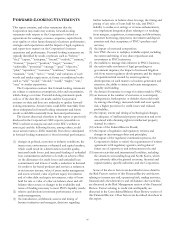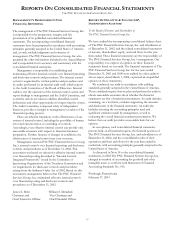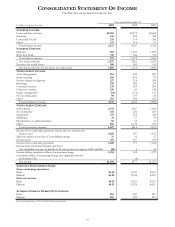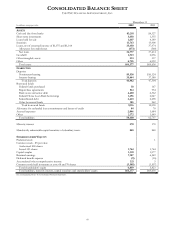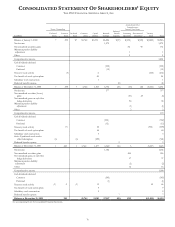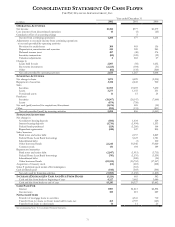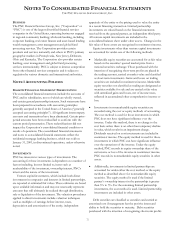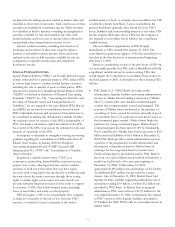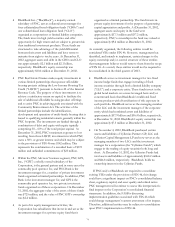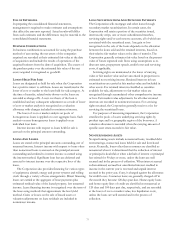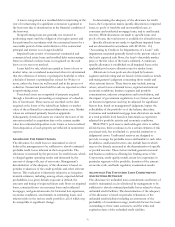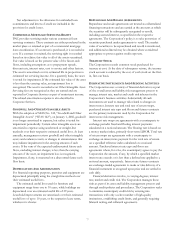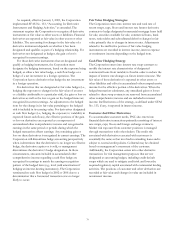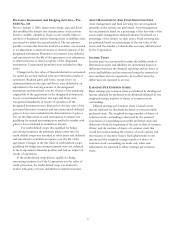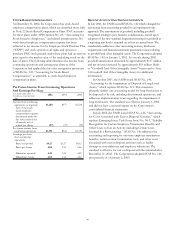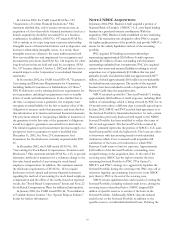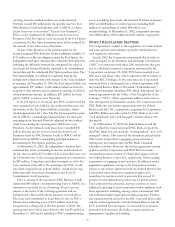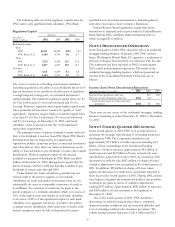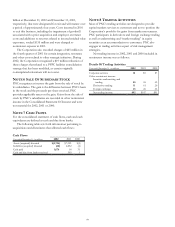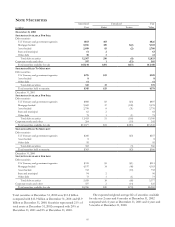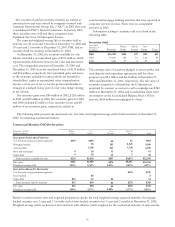PNC Bank 2002 Annual Report Download - page 78
Download and view the complete annual report
Please find page 78 of the 2002 PNC Bank annual report below. You can navigate through the pages in the report by either clicking on the pages listed below, or by using the keyword search tool below to find specific information within the annual report.76
A loan is categorized as a troubled debt restructuring in the
year of restructuring if a significant concession is granted to
the borrower due to deterioration in the financial condition of
the borrower.
Nonperforming loans are generally not returned to
performing status until the obligation is brought current and
has performed in accordance with the contractual terms for a
reasonable period of time and collection of the contractual
principal and interest is no longer doubtful.
Impaired loans consist of nonaccrual commercial and
commercial real estate loans and troubled debt restructurings.
Interest collected on these loans is recognized on the cash
basis or cost recovery method.
Loans held for sale, which are carried at lower of cost or
market value, are considered nonaccrual when it is determined
that the collection of interest or principal is doubtful or when
a default of interest or principal has existed for 90 days or
more, unless the loans are well secured and in the process of
collection. Nonaccrual loans held for sale are reported as other
nonperforming assets.
Foreclosed assets are comprised of property acquired
through a foreclosure proceeding or acceptance of a deed-in-
lieu of foreclosure. These assets are recorded on the date
acquired at the lower of the related loan balance or market
value of the collateral less estimated disposition costs. Market
values are estimated primarily based on appraisals.
Subsequently, foreclosed assets are valued at the lower of the
amount recorded at acquisition date or the current market
value less estimated disposition costs. Gains or losses realized
from disposition of such property are reflected in noninterest
expense.
ALLOWANCE FOR CREDIT LOSSES
The allowance for credit losses is maintained at a level
believed by management to be sufficient to absorb estimated
probable credit losses inherent in the loan portfolio. The
allowance is increased by the provision for credit losses, which
is charged against operating results and decreased by the
amount of charge-offs, net of recoveries. Management’s
determination of the adequacy of the allowance is based on
periodic evaluations of the credit portfolio and other relevant
factors. This evaluation is inherently subjective as it requires
material estimates, including, among others, expected default
probabilities, loss given default, exposure at default, the
amounts and timing of expected future cash flows on impaired
loans, estimated losses on consumer loans and residential
mortgages, and general amounts for historical loss experience,
economic conditions, uncertainties in estimating losses and
inherent risks in the various credit portfolios, all of which may
be susceptible to significant change.
In determining the adequacy of the allowance for credit
losses, the Corporation makes specific allocations to impaired
loans, to pools of watchlist and nonwatchlist loans, to
consumer and residential mortgage loans, and to unallocated
reserves. While allocations are made to specific loans and
pools of loans, the total reserve is available for all credit losses.
Specific allocations are made to significant impaired loans
and are determined in accordance with SFAS No. 114,
“Accounting by Creditors for Impairments of a Loan,” with
impairment measured generally based on the present value of
the loan’s expected cash flows, the loan’s observable market
price or the fair value of the loan’s collateral. A minimum
specific allowance is established on all impaired loans at the
applicable pool reserve allocation rate for similar loans.
Allocations to loan pools are developed by business
segment and risk rating and are based on historical loss trends
and management’s judgment concerning those trends and
other relevant factors. These factors may include, among
others, actual versus estimated losses, regional and national
economic conditions, business segment and portfolio
concentrations, industry competition and consolidation, and
the impact of government regulations. Loss factors are based
on historical experience and may be adjusted for significant
factors that, based on management’s judgment, impact the
collectibility of the portfolio as of the balance sheet date.
Consumer and residential mortgage loan allocations are made
at a total portfolio level based on historical loss experience
adjusted for portfolio activity and economic conditions.
While PNC’s pool reserve methodologies strive to reflect
all risk factors, there continues to be a certain element of risk
associated with, but not limited to, potential estimation or
judgmental errors. Unallocated reserves are designed to
provide coverage for probable losses attributable to such risks.
In addition, unallocated reserves also include factors which
may not be directly measured in the determination of specific
or pooled reserves. These factors include general economic
and business conditions affecting key lending areas of the
Corporation, credit quality trends, recent loss experience in
particular segments of the portfolio, duration of the current
economic cycle, and bank regulatory examination results.
ALLOWANCE FOR UNFUNDED LOAN COMMITMENTS
AND LETTERS OF CREDIT
The allowance for unfunded loan commitments and letters of
credit is maintained at a level believed by management to be
sufficient to absorb estimated probable losses related to these
unfunded credit facilities. The determination of the adequacy
of the allowance is based on periodic evaluations of the
unfunded credit facilities including an assessment of the
probability of commitment usage, credit risk factors for loans
outstanding to these same customers, and the terms and
expiration dates of the unfunded credit facilities.


